The Blockhouse
by: Paul Coté
Most readers will be familiar with Gananoque’s long gone iconic Blockhouse, or at least know the broad strokes. The Blockhouse was built after the raid on Gananoque highlighted Gananoque’s vulnerability to American raids. The Blockhouse was built after the raid on Gananoque and was contracted by Charles McDonald. Its purpose was to protect the harbour and bridge. The bridge was essential for the military dispatch riders traveling from Prescott to Kingston and the harbour had to be covered to protect the naval vessels tied up in the Gananoque River. There doesn’t appear to be any reason to doubt that it was finished by 1813. Gananoque historian, Frank Eames, cites a letter dated 19 January 1813 (page 4) that stated
“. . . the Blockhouse at Gananoque is being constructed and will be complete in about six weeks.”
He was less sure when construction began. Eames cites another letter from Stone to the Honourable Richard Cartwright of Kingston dated 19 October 1812 (page 3).
“I wish your blockhouse had been thought of earlier and mentioned to Col Vincent when you were on the spot. He is alarmed at the expense, and indeed I think that the same purpose might have been answered at a much cheaper rate. What is there to prevent the men themselves from throwing up a building of round logs that would be equally strong and warm, though it would not look as well. By making it double and filling it with earth and sod this would be completely effected . . .”
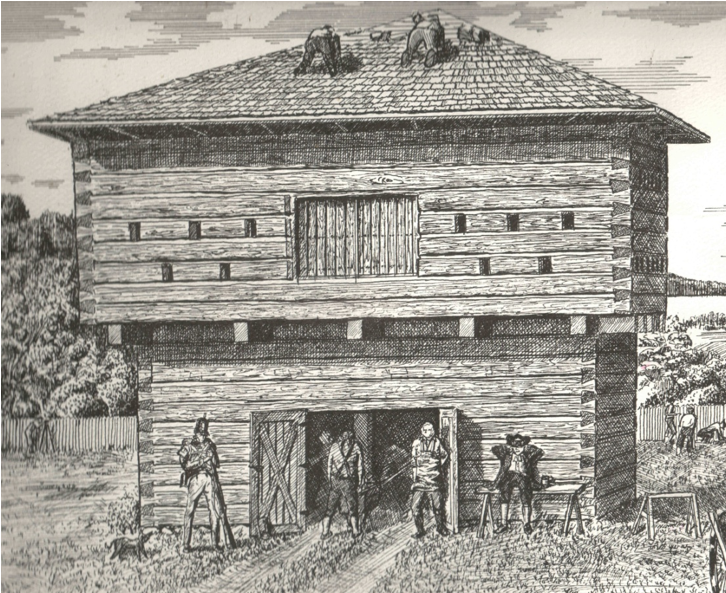
Although Charles McDonald is credited for building the blockhouse, he didn’t do the actual work; that was hired out. We know of one such man. Amaria Howe billed Joel Stone for £1/10/0 for a yoke of oxen and one man for work on the 8th, 9th, and 10th of October 1812 (10 shillings per day).
“Account of the work for my team at Gananoque Blockhouse for government.” [1]
The bill was submitted by Amaria’s son Daniel and was signed off by Thomas F Howland, Ensign. The Blockhouse that was to accommodate two Captains, five subalterns, and 200 men, as well as some canons. The British forces officially left Gananoque in the early 1820s and the blockhouse entered into its period of decline.
The Blockhouse was briefly resurrected in the winter of 1837/38 during the Patriot War or McKenzie Rebellion. Reports of a large group of rebels were reported to be assembling at Clayton, NY, by Elizabeth Barnet who was teaching in Gananoque at the time. Her family lived in Lafargeville, NY, and she had been visiting them when the events took place. She made a dash back to Gananoque across the ice in a horse and sleigh and reported what she had observed. By the time the invaders (dissatisfied Canadians and their American supporters) had assembled for the raid at Hickory Island there were several companies of militiamen lodged at the Blockhouse in Gananoque. RP Colton, in his memoir of that fateful night, written in 1888, reported that he had been ordered to sound the alarm to the west of Gananoque and have the volunteers report to the Blockhouse. He reported that there were 6 or 8 companies of militia then in Gananoque and the Blockhouse was the logical spot for them to be quartered. He mentioned three of the Militia Captains by name: Capt Kilborn of Newboro, Capt Cameron of Kingston, and Capt Murney of Belleville. Although the raid on Gananoque was aborted by the invaders, the countryside was “agitated” for several months. It isn’t clear just how long the militia remained stationed at the Blockhouse in Gananoque.
The Blockhouse remained a landmark until the last timbers were removed in 1859 by William Edwards Sr. He used them in his new shop that he built at the bottom of the hill on the river’s edge below the Blockhouse site.[3] Edwards wasn’t the only one known to cannibalize the old Blockhouse.
“The first sidewalk ever laid in the village was in 1830, two planks wide from the bridge to Charles Street. The plank was some that had been used as a walk around the inside of the Blockhouse fence. Each man bought and laid enough plank to lay the walk in front of his lot. The next was a more substantial walk built in 1844 from the corner of Water and Main Streets up to the International Hotel corner.”[4]
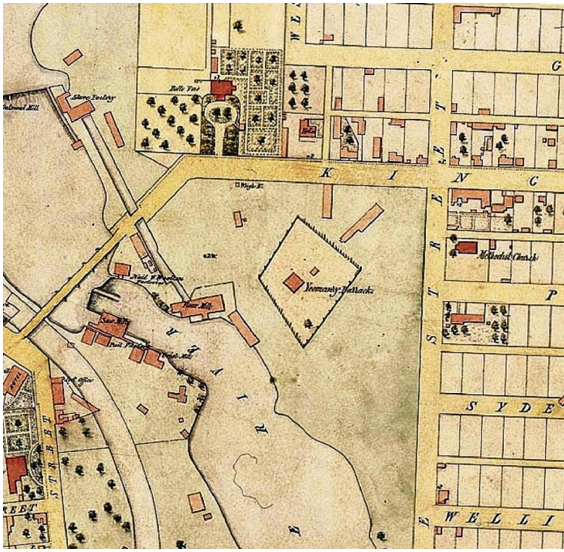
But that is only part of the story. The Blockhouse property was much larger and more important than we imagine today, approximately 5-6 acres. The 1858 Deane map (see map above) shows that it extended all the way to King St and south to Sydenham St. The map captured the extent of the property in its heyday. The Walling map of Gananoque in 1861 (see next map) showed a drastic change that ushered in the beginnings of what we see today. The property didn’t sit idle over the many years that the blockhouse existed. It was used by the citizens of Gananoque for sports events and as a community meeting place. For instance, in May of 1855 it was used for a community event to celebrate Queen Victoria’s birthday. With Canada being a proud colony of the British Empire, the pro-British feelings were the very strong at that time. But the day didn’t start off well:
“On the morning of the auspicious day, the loyal inhabitants of this village were rather surprised to find that during the night some Yankee loafer had been to work and hoisted the “Stars and Stripes” on one of the telegraph poles. This aroused the loyal feeling of the young men of the place, and the dirty rag was soon pulled down and trampled in the dust.”
A Union Jack was then unfurled on the Blockhouse. At noon, the festivities began in the ‘Block House Yard’ with a fusillade of about 50 muskets. In the evening, there was another fusillade, and a huge bonfire was lit. The crowd dispersed at about 10 o’clock with three cheers for the Queen.
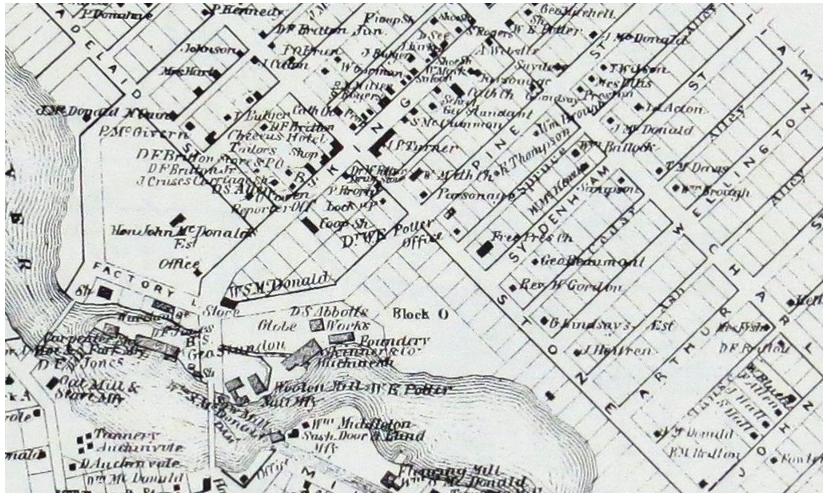
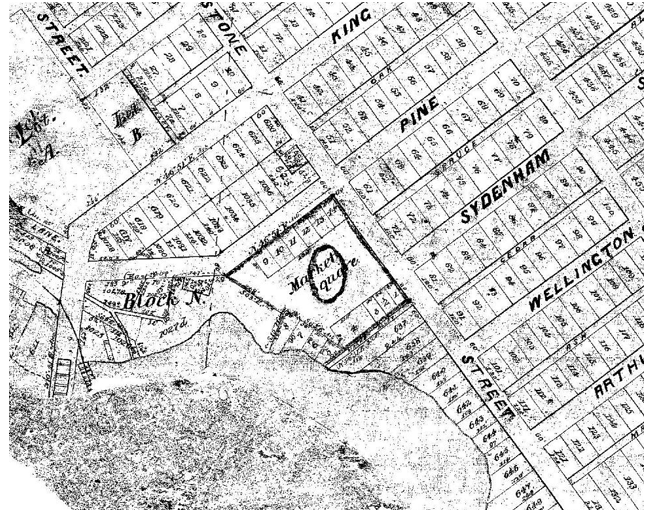
The celebration in 1858[6] was better described and seemed to be a much larger affair. At 4 in the morning, a salvo of artillery woke the village. At ten there was a procession of the Cadets of Temperance to the “Block House Green”[7] followed by the Gananoque Rifles who were preceded by the newly organized Gananoque Brass Band marching from the Militia Drill Room [8] through the streets to the Green. At one o’clock, Woolard’s Hotel put on a feast for the Artillery and Riflemen as well as the band members. This was followed by a ‘grand procession’ from Woolard’s Hotel through the streets of the village. Then the town worthies had a chance to give some rousing speeches. The rest of the afternoon was taken up with gymnastic displays and other entertainment. In the evening, the activities were capped off with a large bonfire and fireworks, and then the three cheers for Queen Victoria before everyone headed home. The crowd was estimated at about 600.
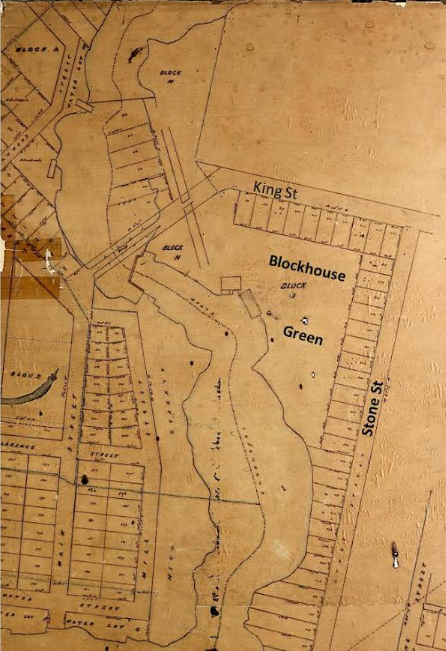
Fittingly, this was also the last hurrah for the Blockhouse and its Green as well. What was left of the blockhouse was demolished the following year. The Green had been partly subdivided as early as 1853 with the lots along King St and Stone St being surveyed but going by the 1858 map, none had been occupied. The Market Square (Block O) was the last to go. In the following decades the Green was gradually built over so that today nothing remains to remind us of that time in our history. It kind of reminds one of the old song about paving over paradise.
Footnotes:
[1] Queen’s Archives, Joel Stone Papers, Document: Account Receipt, 13 Aug 1813.
[2] https://thousandislandslife.com/island-stories-from-the-gananoque-reporter-in-1888/ See the Hickory Island article.
[3] Eames, Gananoque Blockhouse, page 9.
[4] "Gananoque’s Early Days", Gananoque Reporter, 21 Apr 1888, page 2.
[5] The Daily British Whig, The Queen’s Birthday at Gananoque, 28 May 1855.
[6] The Kingston Daily News, "The twenty-fourth in Gananoque", 27 May 1858.
[7] The use of the term Green harkens back to its use in England where most villages had a space dedicated to community events and sports fields. See https://heritagecalling.com/2024/09/26/the-history-of-england-village-greens/
[8] The Drill Shed was located where the Gananoque High School was built in 1898.
By Paul Coté
Paul Coté is a resident of Gananoque. He has socialized and worked on the River for most of his life. History has always been a passion, and he is a self-confessed genealogy addict. Recently retired from contracting on the river, he now has time to pursue and write about his research. He is currently working on a book tentatively titled "The Shaping of Early Gananoque" and he has also published two more books: one titled "One Room Schools" in the Rear of Yonge and Escott Township and another one on "The Early Water Powered Mills and the Evolution of the Roads" concerning the same township. His book, "Sheatown: A Vanished Irish Catholic Community in Protestant Yonge Township, Leeds County" was reviewed in TI Life December 2019 issue. You can view all of Paul's articles in two places - here on our original format and here for articles published since June 2019.


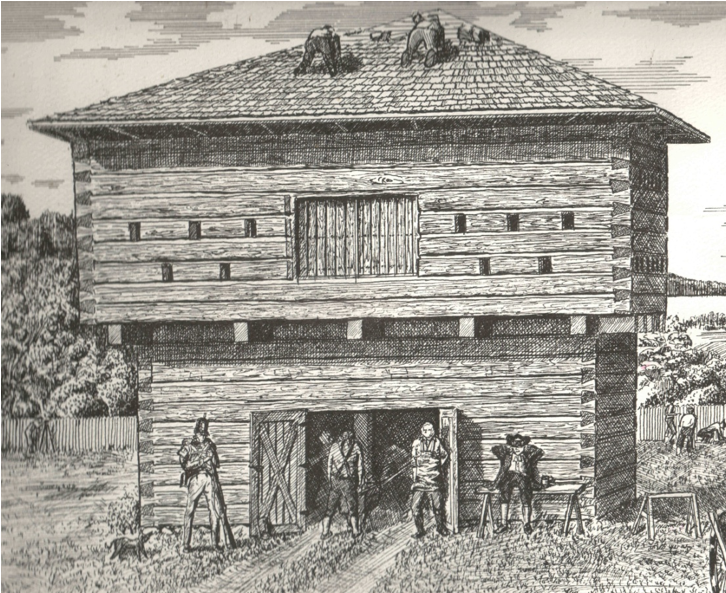



Please click here if you are unable to post your comment.